It was in the 1920s when light-emitting diodes were first invented. Today, eighty years later, LEDs come in variable colors, brightness and wavelength - visible, ultraviolet, and infrared. LEDs have a lot of advantages over traditional lighting which include lower energy consumption, longer lifetime, size, and robustness.
In this article, we will cover fifteen LED hacks that are jaw-dropping, eye-catching and overall awesome. I have decided to group the list based on their use, from trivial and entertainment use to medical uses and architectural purposes.
1. Huge Sky Screen at “The Place” in Beijing, China

Imagine strolling down a street, and 25 meters above you is a giant LED screen display… with dragons and marine animals floating! This massive display located at The Place shopping center at the heart of Beijing, China was placed before the Olympics of 2008. Considered as the largest LED screen in Asia, it has dimensions of 250 meters in length and 30 meters in width. The sky screen plays majestic shows like seascapes, a dolphin show, among others. Note that the biggest LED display belongs to the display screen at Fremont St., in Las Vegas which is made of 12.5 million LEDs and has a length of 460 meters.
2. LED Cyclist Jacket
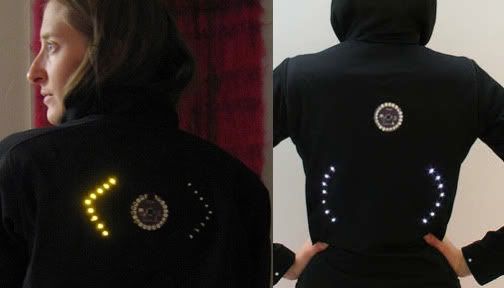
Yes, there are a lot of shirts and pants and other wearable materials out there which make awesome use of LED. Take, for instance, the Iron Man Arc Reactor. But for the usefulness of this next one, I think it should count in my top choices. When she was a Ph.D student at the University of Colorado, Leah Buechley has created an electronic clothing, the signal jacket for cyclists. As you can see from the image above, this is simply ingenious and the usefulness of this goes overboard. The LEDs are powered and programmed by a sewable computer chip which was designed by Leah, herself. For those of you interested in making one, click on the link above for instructions.
3. LED Cubes - Cubatron
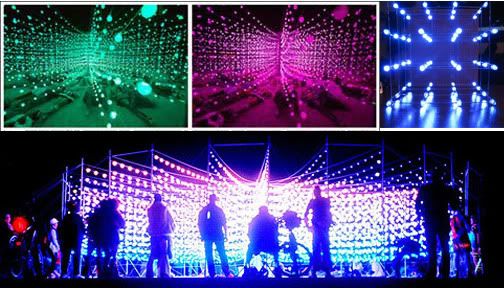
LED cubes are a dime too many but they are nonetheless interesting and an awesome use of LEDs for trivial and entertainment purposes. LED cubes can be as small as the basic 4×4×4 (pertains to the number of LEDs) or could be more extravagant like that of the Cubatron UV with a 100×100×100 matrix or a total of 1,000,000 LEDs. Surely, this is an expensive project to make. The Cubatron UV has its roots down to the first Cubatron, which is now proudly in display at the ultra chic W Hotel in Dallas. The Cubatron (8×8×8 feet) used to be the world’s largest 3-dimensional full color light sculpture, a title which now belongs to the Big Round Cubatron (40 feet in diameter, ten feet in height). The latter made its debut at Burning Man in 2006 and has since been shown at different festivals, events and places. Led cube are perfectly characterized with these words, “a word of art at rest, a hypnotic experience once the micro-controller takes charge.”
4. Extreme LED Art

It’s a big-brand viral video but the fact still remains that this is one of the most awesome use of LEDs. For this viral campaign, Samsung got the help of The Viral Factory in London. It was directed by James Rouse and a group of sheep dog trainers named Baa-Studs. What did they do? The makers strapped thousands of LED lights to hundreds of sheep and took to the hills of Wales to create amazing displays such as a giant game of pong, Mona Lisa and fireworks. You really have to see the video, aptly titled, “Extreme LED Sheep,” which has ben viewed millions of times on youtube.
5. Plant Growth

Scholarly articles have been written documenting the use of LED as artificial light for plant growth and NASA is at the helm of this technology. It has been found out that by utilizing LEDs, one can only use the light spectrum required for photosynthesis. Through this use of specific spectrum, no light is wasted. Moreover, since LEDs are directional, this ensures that the full 100% of the light can be pointed exactly where needed, eliminating the need for reflective materials to direct light. NASA has actually funded more research on this technology for use on space plant growth as LEDs emit less heat, which will prevent the plants from drying out. A new study from USDA Plant Physiologists also reported that they can now grow lettuce with deeper color, which means more antioxidants, through ultraviolet LEDs.
6. Crown Fountain, Chicago, USA
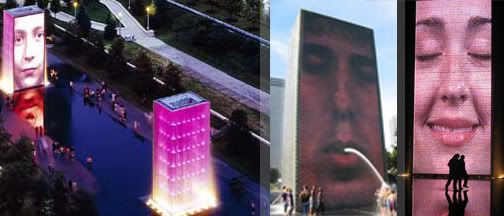
The Chicago Crown Fountain is a public art installation made up of two glass brick towers. It was designed by Jaume Plensa, a Catalan artist, and are said to cost around $17 million - a very high cost which really payed off with how awesome these displays are! The two towers face each other and stand at 50 feet tall. LEDs are used for the massive screens wherein photos and videos of Chicago residents are randomly being played, apart from the usual landscapes. These glass towers also serve as fountains, aside from the cascading water coming from the top, the displays each have a nozzle where water spouts. These towers where unveiled on July 2004 and have since been a popular landmark for Chicagoans to relax and for tourists to marvel.
7. Lessen Wrinkles, Skin Rejuvenation
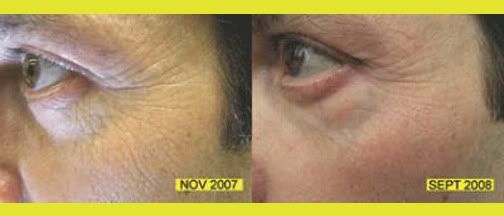
Here’s a possible alternative to Botox: LEDs. A published research from Germany, led by Amdrei Sommer and Dan Zhu of the Institute of Micro and Nanomaterial, at the University of Ulm in Germany, reports that the high intensity visible light from LEDs resulted in “rejuvenated skin, reduced wrinkle levels, juvenile complexion and lasting resilience” when applied daily through a course of several weeks. As light penetrates through skin, it has the ability to cause change in the sub-surface tissue. The visible light from the LEDs help in skin rejuvenation and reducing facial wrinkles by changing the molecular structure of a water layer on elactin - a protein that provides elasticity in the skin, blood vessel, the heart and other body parts. The researches even end their conclusion with “we are justified in believing that our approach can be easily converted to deep body rejuvenation programs.” That is something to look forward to.
8. New Year’s Ball, Times Square, New York, USA

In Times Square, New York, at exactly 11:59 PM of New Year’s Eve, all eyes are on the world-reknowned New Year’s Eve Ball, as it begins it decent. This marks the countdown for the celebration of the New Year. In 2008, the co-organizers, Times Square Alliance and Countdown Entertainment has unveiled the “New” New Year’s Eve Ball. It is a 12 foot geodesic sphere, which is double the size of the previous Waterford Crystals Ball, weighs 11,875 pounds, made of 2,668 Waterford Crystals and lighted by 32,256 Philips Luxeon Rebel LEDs. This ball just got even better, brighter (a palette of 16 million colors and billions of patterns!), and of course, greener. It was such a sight to behold.
9. LED Throwies
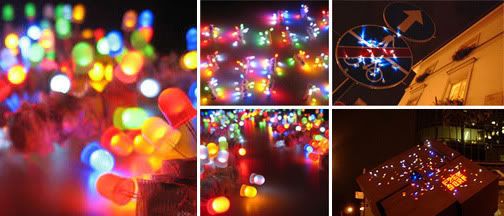
LED Throwies were started by Graffiti Research Lab fellows James Powderly and Evan Roth. They are basically made of a small LED attached to a coin battery and a rare earth magnet by use of epoxy or electrical tape. Some modifications may include designs such as using Velcro instead of magnet; adding an on/off switch; use of flashing LEDs or “blinkies”. Moreover, other creators and DIY guys have made alterations, for instance, “floaties” make use of styrofoam as a floatation device; “sinkies” on the other hand are meant to sink; “flyies” are used as payloads in using helium balloons; while another one are throwies placed inside a balloon or ice cubes with water, frozen overnight. LED throwies are generally used as creative graffiti and light displays but have since been used in various methods.
10. Medical Treatment for Cancer

Turning our focus away form the trivial and entertaining, we take a look at the use of LED in science, specifically in medical cure research such as cancers and other diseases. Dr. Harry T. Whelan, MD, a Professor of Neurology from the Medical College of Wisconsin, is borrowing the broad spectrum LED technology from NASA to help with cancer treatments and therapies. In his research, he has used LEDs for a popular cancer treatment called photo-dynamic therapy or PDT. It has been found out that through the use of LEDs, patients who have undergone it had only mild or no dermatitis compared to patients who have been treated by the usual laser method had some degree of skin radiation. Less radiation dermatitis means that the doctors and therapists may speed up the treatment process for cancer patients. LEDs are also being used in brain surgery such as LED probes with 144 very tiny pinhead-size diodes which serves as a light source during surgery. Moreover, Dr. Whelan is looking into using LEDs for healing burn victims or those with musculo-skeletal injuries. A leading company, Polymetronics, also claims that a red light LED bandage can help with outpatient skin cancer treatment.
11. Harbin Ice and Snow World

What’s more awesome that ice castles? Ice castles lit by thousands and thousands of LEDs! Harbin Ice and Snow World orchestrates the magnificence its annual show through the use of colorful LEDs lighting the various ice sculptures. One of four of its kind in the whole world (Japan’s Sapporo Snow Festival, Canada’s Quebec City Winter Carnival, and Norway’s Ski Festival), the Harbin Ice and Snow World covers several parks for the ice sculptures–including the world’s largest snow Santa Claus, castles copied from real world towering wonders, churches, mosques, and a lot more! For 2009, it took 8,000 workers and 32 million gallons of water to make all the blocks! And because this year, they decided to use LEDs, the towers and sculptures are even more majestic at night. Let the picture speak for themselves. Jaw dropping.
12. 2008 Olympics, China
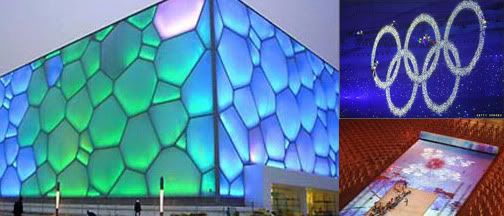
The Olympics 2008 show of China easily trumps most, if not all, of the past Olympic shows. Architectural wonders are the buildings such as The Bird’s Nest and The Water Cube have been build for the Olympic celebrations. And LEDs played a big role in making the celebrations as marvelous as they were. The Bird’s Nest was installed with LEDs while The Water Cube was lit by 500,000 LEDs. However, it was the opening and closing ceremonies which count as the most unforgettable and mesmerizing. Remember that gigantic scroll? It made use of 44,000 colorful LED beads, 600 millimeter apart, in its dimension of 147 meters by 22 meters. LEDs were widely utilized throughout the show, from the performers’ costumes to the massive LED lit globe and the Olympic rings, complete with fairies floating.
13. Optimus Maximus
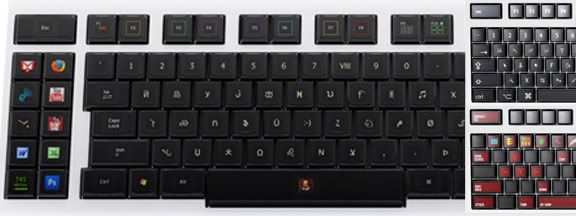
There are a lot of peripherals wisely using LEDs out there in the market. But when it comes to keyboards, the Optimus Maximus, from its very name, is the king of them all. Coming from the well-respected Art. Lebedev Studio design company in Russia, the Optimus Maximus works by assigning functions to its keys. Its has a full customizable layout and is a perfect companion for design, video editing, gaming. The keys also dynamically change based on user interaction (press shift key and all appropriate keys will change to upper case). For a history tidbit, the first LCD keyboard was developed in Germany during the mid 1980s and was sold until 1999. I personally am hoping to see full-on LED trackpads.
14. Light-Emitting Wallpaper

Jonas Samson is a true creative genius in my book. He has acknowledged the under utilization of organic light emitting diodes or OLEDs to create something other than flexible computer or TV screens, not that such use is not awesome in itself. Jonas Samson is the proud maker of the light-emitting wallpaper, which looks like a plain wallpaper - it has a two-dimensional surface instead of a 3D object. It is the perfect combination of graphic design, textile, and technology. What makes this more awesome than it is? You can easily turn on the part of the graphic/wallpaper you want to light up! In Jonas’ website he writes: “As long as the wallpaper is turned 'off', it is indistinguishable as a source of light. Instead, it is just what it appears to be: wallpaper.”
15. LED for Wireless Communication

With their current goal of reaching 10Mbps wireless connection, researchers at Boston University’s Smart lighting Engineering Research Center gained a $18.5 million grant from the National Science Foundation. Their aim is to replace the current use of wireless routers with lighting access points through LEDs. Wouldn’t it to over the top awesome to just turn on the lights and be able to receive and access wireless signal? This means lower power consumption, convenience, better security because it relies on visible light and greater transmission speeds (no electromagnetic interference). This technology is certainly not yet available to the market, but the ease of changing your light bulbs with LEDs is certainly a good reason to wait for it.
So there you have it, 15 of the most awesome uses of light-emitting diodes. I hope you had a good read. Hit the comments with what ranks as the best for you.

0 comentários:
Enviar um comentário